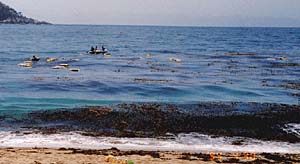







Though there are a few rare freshwater species, the brown algae dwell almost exclusively in marine (or coastal) environments. Members of the group dominate many benthic marine biotas, sometimes reaching from the ocean floor to its surface. In general, they are not free-floating organisms, but are attached to rock, coral, or other firm surfaces.
The group is found primarily in colder waters of the northern hemisphere, with the largest forms occurring in cooler waters, rather than in the tropics. Many familiar species, such as rockweed, are intertidal, and are exposed to the air at low tide.

Two species constitute the majority of the algae here, primarily Sargassum natans, and most of the rest is Sargassum fluitans. These two species apparently evolved from other anchored species of Sargassum, providing the basis of this bizarre ecosystem. Sargassum stays afloat by producing gas-filled bladders which act like buoys. You can see these in the picture at left; the picture also shows the typical jagged-edged blades. Life here is precarious for animals who are poor swimmers -- they must maintain a firm grip on floating mats of kelp, or be lost to the ocean depths.
Such a floating ecosystem of course will have difficulties in acquiring nutrients, and will therefore be severely limited by access to such nutrients. Many of the organisms which live here survive by being generalists, not limiting themselves to a single food source but making use of whatever is available. The most common crab is a generalist carnivore, eating many different kinds of prey. It is also interesting that this ecosystem has no animals which are strict herbivores, but rather they are omnivores, switching between diets of eating algae and animals. This may in part be due to the rubbery, chemical-laden nature of Sargassum.
The accumulated mats of Sargassum support a wide variety of animal life, some of which depend on the kelp for only a part of their life. Other organisms spend their whole life among the algae, and this diversity of life has been called a "floating jungle". Some of the more unusual forms include fish and crabs which are camouflagued to look like Sargassum. Perhaps the best known of these is the pipefish Syngnathus pelagicus, a relative of the seahorse. This fish is brownish-green, and is covered by flaps of skin which resemble the kelp blades. There are more than 50 fish species whose lives are linked to Sargassum, and a myriad of invertebrates, including gastropods, polychaetes, bryozoans, anemones, and sea-spiders. The most numerous inhabitants are hydroids and copepods.
Algae and plants which live here must also contend with many herbivores which live in these near-shore communities. Heavy grazing may damage and weaken the holdfasts which anchor the algae. Exposure at low tide also means that these organisms risk dessication, which is reduced by the presence of gelatinous compounds such as algin.
The largest kelps are diploid, and release flagellated swimming sperm into the water to find egg cells. It has been shown that chemical signals called pheromones aid the sperm in their quest in at least some phaeophytes.
More information about kelp forests is available from the Monterey Bay Aquarium or view a picture from the Stephen Birch Aquarium-Museum at the Scripps Institute of Oceanography in San Diego.
The Bermuda Atlantic Time-Series Study is collecting data on biogeochemical cycling in the Sargasso Sea. Their site includes much data and some nice satellite photographs. Or read this Research Paper by William W. Bushing on kelp populations around Santa Catalina Island, CA.

Sources:
J. N. Butler, et al. 1983. Studies of Sargassum and the Sargassum Community.
Bermuda Biological Station Special Publication No. 22.
J. H. Ryther. 1956. The Sargasso Sea. Scientific American 194(1):98-104.

